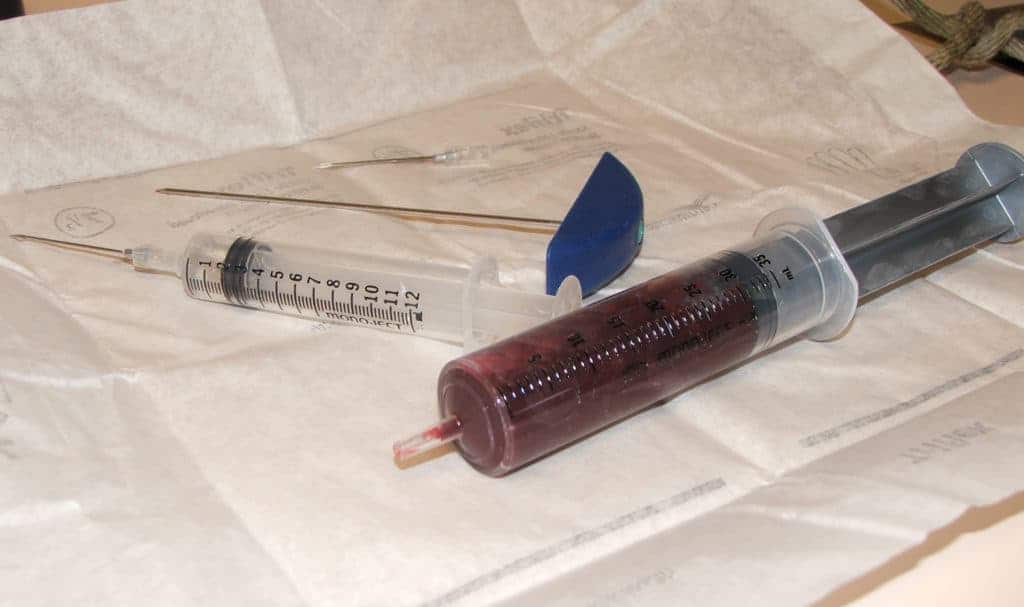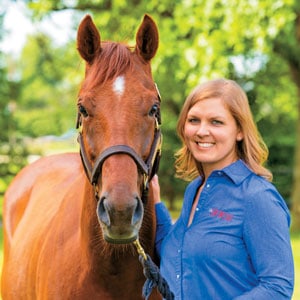The ABCs of Stem Cells and Regenerative Medicine for Horses

In addition to moderating the session, Watts, who is assistant professor at the university’s College of Veterinary Medicine & Biomedical Sciences, in College Station, was tasked with breaking regenerative medicine down to the basics for veterinarians. “The first thing for stem cells is we really need to understand what in fact is a stem cell?” she said. “It’s a cell that can do two things through asymmetric division. One half of the cell division creates a cell to replace itself, or self-renew. The second half of the cell division can become different tissue types, or differentiate.”
There are several types of stem cells to understand before diving into the world of regenerative medicine. A few of them might sound familiar due to ethical debates in mainstream media about the human versions, but here we’ll spell them out for equine use.
Embryonic stem cells
Referred to as “the ultimate stem cell,” the embryonic stem cell is present approximately one week after conception. These cells are pluripotent, meaning they can become any type of equine cell that is present in the adult horse.
After Day 8 of embryonic development there are still stem cells present, but they will be committed to one germ line (group of tissue types) and no longer considered embryonic. Being committed to one germ line means the stem cells have transitioned from pluripotent to multipotent and are considered adult-derived, even though they are found in the developing fetus.
Adult-derived stem cells
Little pockets of lineage-committed stem cells can be found in nearly all adult tissues throughout life. The horse’s body calls on these for normal remodeling and repair, and they’re quite effective at their jobs, which is why veterinarians have targeted them for extraction and culture as a therapy. However, the older these cells become, the less flexible they become, so to speak; they don’t multiply (expand) as easily in culture, they don’t differentiate into different types of cells as readily, and they simply aren’t as powerful as they once were. So there’s been a growing interest in banking embryonic and fetal-derived stem cells for future use.
Mesenchymal stem cells
These are the MSCs mentioned earlier and are basically adult-derived stem cells derived from just about any tissue in the body. But if your horse has been treated with MSCs, they most likely came from bone marrow or fat tissue. These cells have their roots in a certain type of tissue and are isolated, and each individual cell can be expanded to many millions in the laboratory. Once isolated from the donor tissue’s other cell types, the stem cells can be used to treat a variety of different tissues. Although the cells isolated from fat and bone marrow are of the same type, MSCs, they might have donor tissue-specific differences.
“To date, bone-marrow-derived MSCs from both the horse and human have been the most thoroughly studied and have the most evidence for the ability to undergo chondrogenesis, tenogenesis, and osteogenesis (production of cartilage, tendon, and bone tissue, respectively) and might contribute to … repair (of these tissue types) as well as modulate inflammation and soft tissue repair within the joint,” she said.
Even among the MSCs we have stem cell subsets:
Autologous stem cells Autologous means that the cell or tissue used in a patient is from that individual, or is self-derived. Several academic and commercial laboratories isolate, expand, and freeze stem bone marrow, fat, umbilical cord, and blood cells for autologous use, meaning veterinarians will inject the stem cells back into the same horse from which they extracted them. Watts said each lab provides direction to veterinarians for collection and shipping. This “self” therapy means there’s minimal risk for disease transmission, but the flip side is there’s a necessary delay for treatment: The isolation and expansion process takes approximately three weeks. Watts explained that, yes, banking is possible, but currently the long-term efficacy of frozen-thawed MSCs many years later isn’t clear.
Allogeneic stem cells Allogeneic means the cell or tissue used in a patient is from a different individual of the same species. Laboratories could prepare allogeneic MSCs from a donor horses and bank them to be used in in the next injured horse(s). Therefore, allogeneic MSCs would be considered an “off-the-shelf” option. Allogeneic MSCs are considered essentially the same as a drug by the FDA, and as such the FDA would require the same safety and efficacy studies required for pharmaceuticals. This is a very costly and difficult process, but is especially difficult for cellular therapies. Therefore, commercial allogeneic stem cells aren’t available just yet.
Then we have the non-stem-cell regenerative medicine approaches.
Platelet-Rich Plasma (PRP, aka platelet-reduced plasma)
“Platelets are the body’s first-responders after any injury,” she said, referring to how this segment of the blood can release many bioactive substances that promote healing, stimulate blood vessel formation, recruit from those pockets of endogenous stem cells mentioned earlier, and control inflammation. “PRP is plasma with a platelet count above that of whole blood.” Companies and veterinarians prepare autologous PRP by separating liquid and solid parts of blood; it can be done patient-side for immediate use, which means it’s a relatively inexpensive approach.
“There are three ways it can be made, depending on how the sample is handled,” Watts explained. These approaches, which include pure PRP, leukocyte PRP, and leukocyte-reduced PRP, reflect the ratio of platelets to leukocytes (specialized white blood cells that aid in healing) in the final product to be returned to the horse’s body.
Watts said veterinarians report varying efficacy with PRP, and that probably has a lot to do with this variation in product composition. Currently the “ideal” makeup is undefined. Theoretically, a higher concentration of platelets would mean more growth factors to help the horse’s tissue heal, and a study of tendon and ligament gene expression in Dr. Fortier’s lab at Cornell University supports this. But in that same study increases in leukocytes caused the cellular equivalent of scar tissue to form, she explained, which is counterproductive to building functional healed tissue. Anecdotally, veterinarians have reported joint flares (injection-caused inflammation in the joint) following PRP administration that might be related to these concentrations.
Some of PRP’s advantages are that it can be frozen, she said, but it’s important to note that freezing damages the leukocytes and activates the platelets (causing them to release their contents). Also, fresh PRP can be used to form a clot in an injury if the veterinarian adds thrombin and calcium. “Clinical anecdotes suggest that PRP is useful for acute (recent) tendon and ligament injury when injected intralesionally (directly into the injury) under ultrasound guidance,” she noted.
So the jury is still out on the optimal PRP potion, and to figure it out we need careful and well-described scientific reports. “As veterinarians report their results with PRP, it’s important for us to know how that PRP was made and the proportion of platelets and white blood cells,” she explained.
Autologous conditioned serum (ACS)
“We use ACS to upregulate (increase the cellular response to the naturally occurring) interleukin-1 receptor antagonist protein (IL-1RA; IRAP) to block the activity of interleukin-1,” said Watts. Inhibiting interleukin-1, which is a potent inflammatory mediator, translates to pain relief and reduced inflammation for the injured or arthritic horse.
“We do that with the glass beads overnight,” she said, referring to commercially available kits that involve incubating blood with medical-grade glass beads that cause leukocytes (white blood cells, specifically the macrophages) and platelets to produce and release endogenous substances, such as IL-1RA. “Although IL-1RA is the target protein made in this process, there are probably a large and diverse set of (growth) factors present in ACS that makes it effective.”
Veterinarians use ACS in intra-articular (IA) injections to treat joint disease, osteoarthritis, or synovitis (inflammation of the joint lining). Joint flares have been reported, but infrequently. Veterinarians have also injected ACS in and around tendons and ligaments.
Growth factors
Watts touched on this experimental area of treatment, which at its most basic level involves adding substances to the body to encourage functional tissue production—a lot like the other regenerative medicine approaches, only we’re going for particular proteins here. Veterinarians can introduce these factors directly by injecting proteins, or they can do it indirectly by using gene therapy techniques to stimulate protein production. Researchers have been studying the latter approach because it has the potential of continued expression in the body, whereas proteins you inject directly don’t last very long because the horse’s body metabolizes them like they would anything else. The players in this category comprise a whole other set of acronyms, including TGF, IGF, BMP, and GHRH.
TGF-β (transforming growth factor-β) and IGF (insulin-like growth factor) have been injected in horses as proteins or used as gene therapy to stimulate healing of hyaline cartilage (normal cartilage within the joint) and tendon, respectively.
Bone morphogenic protein (BMP) has been injected into horses as proteins or used as gene therapy in fractures and cystlike lesions to stimulate exactly what you might expect: bone production.
IGF has been used with gene therapy in tendon lesions to stimulate repair (noted above).
Growth-hormone-releasing hormone (GHRH) gene therapy has been used to treat laminitis.
IL-1Ra gene therapy has been used to treat joint inflammation.
This begs the question: What exactly is gene therapy? Well, again, at its most basic this process involves using the shell of a virus (usually, though nonviral vectors are available) to introduce these growth factors to the horse’s body in a directed way to enhance repair after injury. “Gene therapy techniques are not yet available for clinical application but may become a routine part of practice in the future,” said Watts.
From A to Z
Watts finished up, noting that though veterinarians have come a long way in understanding and using regenerative medicine, they still have a lot to learn about how and when to use it; there’s much to be clarified still as far as indications (which cases to use it in), technique, route, dose, timing, and frequency.
Also keep in mind that every horse is different physiologically and every collection and processing of blood or tissue samples might result in slightly different products. This means every autologous product might be distinct, which complicates research results. Only through accurate reporting on the clinical use of regenerative medicine techniques and well-designed trials will veterinarians be able to hone in on the best therapies and protocols for horses.
Still, veterinarians must keep an eye on emerging studies to know what regenerative therapies are available and the best approach for each. “Regenerative medicine is a very rapidly changing field,” Watts said, “and what we know today can change tomorrow.” For now, something all camps in the regenerative medicine field seem to agree on is that early treatment, prior to the production of scar tissue, and possibly repeated treatment are best to heal the injured tissue and keep the horse at its pre-injury performance level.

Written by:
Stephanie L. Church, Editorial Director
Related Articles
Stay on top of the most recent Horse Health news with















